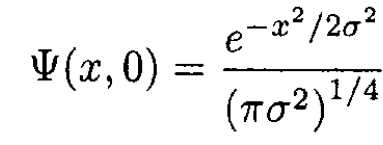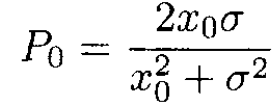
Given a Gaussian
 المؤلف:
Sidney B. Cahn, Gerald D. Mahan And Boris E. Nadgorny
المؤلف:
Sidney B. Cahn, Gerald D. Mahan And Boris E. Nadgorny
 المصدر:
A GUIDE TO PHYSICS PROBLEMS
المصدر:
A GUIDE TO PHYSICS PROBLEMS
 الجزء والصفحة:
part 2 , p 56
الجزء والصفحة:
part 2 , p 56
 14-8-2016
14-8-2016
 1321
1321
Given a Gaussian
A particle of mass m is coupled to a simple harmonic oscillator in one dimension. The oscillator has frequency ω and distance constant x20 = h/mω. At time t = 0 the particle’s wave function ψ (x, t) is given by
 (i)
(i)
The constant σ is unrelated to any other parameters. What is the probability that a measurement of energy at t = 0 finds the value of E0 = hω/2?
SOLUTION
Denote the eigenfunctions of the harmonic oscillator as ѱn(x) with eigenvalue En. They are a complete set of states, and we can expand any function in this set. In particular, we expand our function Ψ(x, 0) in terms of coefficients an:
 (1)
(1)
 (2)
(2)
The expectation value of the energy is the integral of the Hamiltonian H for the harmonic oscillator:
 (3)
(3)
where we used the fact that Hѱn = En ѱn. The probability Pn of energy En is |an|2. So the probability of E0 is given by
 (4)
(4)
where
 (5)
(5)
and finally
 (6)
(6)
It is easy to show that this quantity is less than unity for any value of σ ≠ x0 and is unity if σ = x0.
 الاكثر قراءة في مواضيع اخرى
الاكثر قراءة في مواضيع اخرى
 اخر الاخبار
اخر الاخبار
اخبار العتبة العباسية المقدسة


